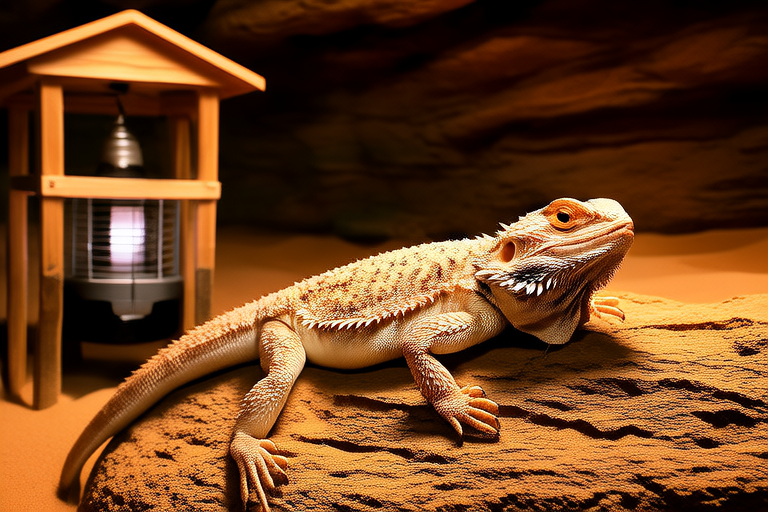How to Create the Perfect Habitat for Your Happy, Healthy Bearded Dragon
Welcome to the wonderful world of bearded dragons! These charismatic reptiles are popular pets due to their docile nature and fascinating behaviors. However, providing them with a perfect habitat is crucial for their happiness and health. This comprehensive guide will walk you through setting up an ideal environment, covering everything from enclosure size to dietary considerations.
Choosing the Right Enclosure Size
The first step in creating a perfect habitat is selecting an appropriately sized enclosure. Adult bearded dragons require at least a 40-gallon (151-liter) tank, while juveniles can start in a smaller 20-gallon (75-liter) tank. Larger enclosures offer more space for exercise and exploration, reducing stress and promoting physical activity. Ensure that the tank has secure, well-ventilated lids to prevent escapes.
Temperature and Lighting Requirements
Maintaining the correct temperature gradient within the enclosure is vital for your bearded dragon’s overall health. The tank should have a hot spot reaching around 95-110°F (35-43°C) and a cooler area around 80-85°F (27-29°C). Use a digital thermometer and multiple thermometers placed throughout the enclosure to monitor these temperatures accurately.
UVB lighting is essential for calcium metabolism and vitamin D3 synthesis, which are necessary for bone health. A high-quality UVB bulb should be positioned so that it provides direct light onto basking areas within the enclosure. Replace bulbs every six months or according to the manufacturer’s recommendations, as UVB output diminishes over time. Additionally, ensure that the bulb is placed at an appropriate distance from the basking area to avoid overheating and burns.
Suitable Substrate Options
Selecting the right substrate is critical to preventing impaction and ensuring your bearded dragon’s digestive system remains healthy. Avoid substrates like sand, gravel, and walnut shells, as they pose a choking hazard. Instead, opt for safer alternatives such as paper towels, reptile carpet, or non-clumping cat litter. These substrates are easy to clean and less likely to cause health issues.
Hiding Spots and Climbing Structures
Bearded dragons enjoy exploring and need places to hide and climb. Incorporate various branches, rocks, and artificial plants to create a stimulating environment. Ensure that all structures are securely anchored to prevent accidents. Providing multiple hiding spots helps reduce stress and promotes natural behaviors. Arrange these elements to encourage movement between different temperature zones within the enclosure.
Proper Ventilation
Ensure that the enclosure has adequate ventilation to maintain air circulation and prevent stagnant air, which can lead to respiratory issues. Proper ventilation also helps regulate humidity levels within the tank. Avoid placing the enclosure in drafty areas or near heating sources that could cause temperature fluctuations.
Humidity Levels
Bearded dragons thrive in low-humidity environments, typically ranging between 20% and 40%. High humidity can contribute to respiratory infections and skin problems. Monitor humidity levels using a hygrometer and adjust as needed by increasing ventilation or adding a small water dish if necessary.
Dietary Considerations
A balanced diet is key to maintaining your bearded dragon’s health. Offer a variety of insects, including crickets, dubia roaches, and mealworms, dusted with calcium and multivitamin powders. Supplement their diet with leafy greens such as collard greens, mustard greens, and turnip greens. Avoid feeding iceberg lettuce, spinach, and rhubarb, as these can be harmful.
Cleaning and Maintenance
Regular cleaning is essential for maintaining a healthy environment. Clean the enclosure weekly, removing waste and uneaten food. Deep clean the tank every two weeks, washing all surfaces and replacing substrate as needed. Disinfecting with a pet-safe cleaner helps prevent bacterial growth and keeps your bearded dragon safe from illness.
Monitoring Your Bearded Dragon’s Health
Observe your bearded dragon daily to monitor its behavior, appetite, and overall appearance. Look for signs of lethargy, decreased appetite, or changes in stool consistency, which may indicate underlying health issues. Regular veterinary check-ups are recommended to catch potential problems early and ensure your bearded dragon stays healthy.
Conclusion
Creating the perfect habitat for your bearded dragon requires attention to detail and regular maintenance. By following these guidelines, you’ll provide your scaly friend with a comfortable, stimulating environment that promotes optimal health and happiness. Remember, a well-cared-for bearded dragon makes for a rewarding and enjoyable companion.
